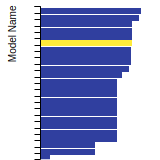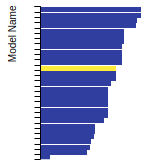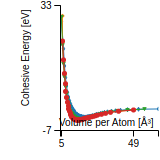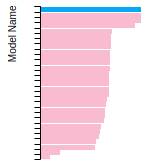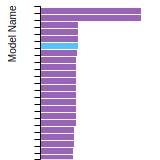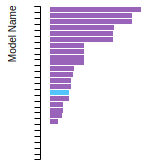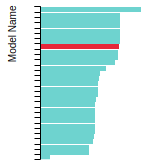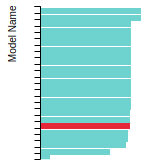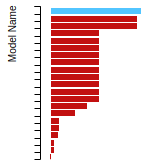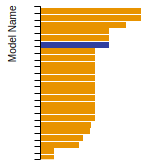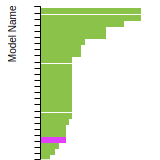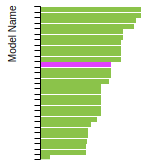 EAM_Dynamo_ZhouZimmermanWong_2008_PdH__MO_114797992931_000
EAM_Dynamo_ZhouZimmermanWong_2008_PdH__MO_114797992931_000
| Title
A single sentence description.
|
EAM potential (LAMMPS cubic hermite tabulation) for the Pd-H system developed by Zhou et al. (2008) v000 |
|---|---|
| Description
A short description of the Model describing its key features including for example: type of model (pair potential, 3-body potential, EAM, etc.), modeled species (Ac, Ag, ..., Zr), intended purpose, origin, and so on.
|
Palladium hydrides have important applications. However, the complex Pd–H alloy system presents a formidable challenge to developing accurate computational models. In particular, the separation of a Pd–H system to dilute (α) and concentrated (β) phases is a central phenomenon, but the capability of interatomic potentials to display this phase miscibility gap has been lacking. We have extended an existing palladium embedded-atom method potential to construct a new Pd–H embedded-atom method potential by normalizing the elemental embedding energy and electron density functions. The developed Pd–H potential reasonably well predicts the lattice constants, cohesive energies, and elastic constants for palladium, hydrogen, and PdHx phases with a variety of compositions. It ensures the correct hydrogen interstitial sites within the hydrides and predicts the phase miscibility gap. Preliminary molecular dynamics simulations using this potential show the correct phase stability, hydrogen diffusion mechanism, and mechanical response of the Pd–H system. |
| Species
The supported atomic species.
| H, Pd |
| Disclaimer
A statement of applicability provided by the contributor, informing users of the intended use of this KIM Item.
|
None |
| Content Origin | NIST IPRP (https://www.ctcms.nist.gov/potentials/Pd.html#Pd-H) |
| Contributor |
Ellad B. Tadmor |
| Maintainer |
Ellad B. Tadmor |
| Developer |
Xiaowang Zhou Jonathan A. Zimmerman Bryan M. Wong J. J. Hoyt |
| Published on KIM | 2018 |
| How to Cite | Click here to download this citation in BibTeX format. |
| Citations
This panel presents information regarding the papers that have cited the interatomic potential (IP) whose page you are on. The OpenKIM machine learning based Deep Citation framework is used to determine whether the citing article actually used the IP in computations (denoted by "USED") or only provides it as a background citation (denoted by "NOT USED"). For more details on Deep Citation and how to work with this panel, click the documentation link at the top of the panel. The word cloud to the right is generated from the abstracts of IP principle source(s) (given below in "How to Cite") and the citing articles that were determined to have used the IP in order to provide users with a quick sense of the types of physical phenomena to which this IP is applied. The bar chart shows the number of articles that cited the IP per year. Each bar is divided into green (articles that USED the IP) and blue (articles that did NOT USE the IP). Users are encouraged to correct Deep Citation errors in determination by clicking the speech icon next to a citing article and providing updated information. This will be integrated into the next Deep Citation learning cycle, which occurs on a regular basis. OpenKIM acknowledges the support of the Allen Institute for AI through the Semantic Scholar project for providing citation information and full text of articles when available, which are used to train the Deep Citation ML algorithm. |
This panel provides information on past usage of this interatomic potential (IP) powered by the OpenKIM Deep Citation framework. The word cloud indicates typical applications of the potential. The bar chart shows citations per year of this IP (bars are divided into articles that used the IP (green) and those that did not (blue)). The complete list of articles that cited this IP is provided below along with the Deep Citation determination on usage. See the Deep Citation documentation for more information. 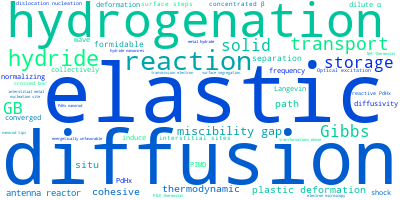
78 Citations (51 used)
Help us to determine which of the papers that cite this potential actually used it to perform calculations. If you know, click the .
USED (definite) M. Ponga and D. Sun, “A unified framework for heat and mass transport at the atomic scale,” Modelling and Simulation in Materials Science and Engineering. 2018. link Times cited: 15 Abstract: We present a unified framework to simulate heat and mass tra… read more USED (definite) X. W. Zhou and S. Foiles, “Uncertainty Quantification and Reduction of Molecular Dynamics Models.” 2017. link Times cited: 9 Abstract: Molecular dynamics (MD) is an important method underlying th… read more USED (high confidence) C. Tang, G. Sun, and Y. Liu, “Impact of host phonons on interstitial diffusion,” Scientific Reports. 2022. link Times cited: 0 USED (high confidence) J. Bian, L. Yang, W. Yuan, and G. Wang, “Influence of hydrogenation on the mechanical properties of Pd nanoparticles,” RSC Advances. 2021. link Times cited: 1 Abstract: Atomic simulations are conducted to investigate the influenc… read more USED (high confidence) K. Sytwu et al., “Driving energetically unfavorable dehydrogenation dynamics with plasmonics,” Science. 2020. link Times cited: 36 Abstract: Coaxing unreactive sites Optical excitation of localized sur… read more USED (high confidence) R. B. Schwarz, A. Khachaturyan, A. Caro, M. Baskes, and E. Martinez, “Coherent phase decomposition in the Pd–H system,” Journal of Materials Science. 2020. link Times cited: 6 USED (high confidence) J. Méndez and M. Ponga, “MXE: A package for simulating long-term diffusive mass transport phenomena in nanoscale systems,” Comput. Phys. Commun. 2019. link Times cited: 8 USED (high confidence) A. M. Igoshkin, “Molecular Dynamics Study of the Deposition of Palladium-Silver Films on a Silver Substrate,” Journal of Structural Chemistry. 2019. link Times cited: 0 USED (high confidence) X. Sun, M. P. Ariza, M. Ortiz, and K. G. Wang, “Atomistic modeling and analysis of hydride phase transformation in palladium nanoparticles,” Journal of the Mechanics and Physics of Solids. 2019. link Times cited: 11 USED (high confidence) G. Bonny et al., “Classical interatomic potential for quaternary Ni–Fe–Cr–Pd solid solution alloys,” Modelling and Simulation in Materials Science and Engineering. 2018. link Times cited: 9 Abstract: In this paper, we present a new quaternary interatomic poten… read more USED (high confidence) X. Zhou, T. W. Heo, B. C. Wood, V. Stavila, S. Kang, and M. Allendorf, “Molecular dynamics studies of fundamental bulk properties of palladium hydrides for hydrogen storage,” Journal of Applied Physics. 2018. link Times cited: 7 Abstract: Solid-state hydrogen storage materials undergo complex phase… read more USED (high confidence) G. Venturini, K. G. Wang, I. Romero, M. P. Ariza, and M. Ortiz, “Atomistic long-term simulation of heat and mass transport,” Journal of The Mechanics and Physics of Solids. 2014. link Times cited: 38 USED (high confidence) J. H. He, D. Knies, G. Hubler, K. Grabowski, R. J. Tonucci, and L. Dechiaro, “Hydrogen segregation and lattice reorientation in palladium hydride nanowires,” Applied Physics Letters. 2012. link Times cited: 7 Abstract: We study palladium hydride nanowires of different sizes and … read more USED (high confidence) H. Pham, B. Arman, S. Luo, and T. Çagin, “Shock compression and spallation of palladium bicrystals with a Σ5 grain boundary,” Journal of Applied Physics. 2011. link Times cited: 9 Abstract: We investigate an elementary process of shock response of gr… read more USED (high confidence) M. Ceriotti, M. Parrinello, T. Markland, and D. Manolopoulos, “Efficient stochastic thermostatting of path integral molecular dynamics.,” The Journal of chemical physics. 2010. link Times cited: 255 Abstract: The path integral molecular dynamics (PIMD) method provides … read more USED (low confidence) X. Sun, “Exploring solute-defect interactions in nanosized palladium hydrides across multiple time scales,” Computational Materials Science. 2023. link Times cited: 0 USED (low confidence) D. Chow, N. Burns, E. Boateng, J. van der Zalm, S. Kycia, and A. Chen, “Mechanical Exfoliation of Expanded Graphite to Graphene-Based Materials and Modification with Palladium Nanoparticles for Hydrogen Storage,” Nanomaterials. 2023. link Times cited: 0 Abstract: Hydrogen is a promising green fuel carrier that can replace … read more USED (low confidence) Z. Dong et al., “Efficient Pd on Carbon Catalyst for Ammonium Formate Dehydrogenation: Effect of Surface Oxygen Functional Groups,” SSRN Electronic Journal. 2022. link Times cited: 4 USED (low confidence) J. Hong et al., “Metastable hexagonal close-packed palladium hydride in liquid cell TEM,” Nature. 2022. link Times cited: 21 USED (low confidence) C. Tang, G. Sun, and Y. Liu, “Is hydrogen diffusion in amorphous metals non-Arrhenian?,” International Journal of Hydrogen Energy. 2022. link Times cited: 3 USED (low confidence) A. Landers et al., “Dynamics and Hysteresis of Hydrogen Intercalation and Deintercalation in Palladium Electrodes: A Multimodal In Situ X-ray Diffraction, Coulometry, and Computational Study,” Chemistry of Materials. 2021. link Times cited: 7 USED (low confidence) S. Paul, D. Schwen, M. Short, and K. Momeni, “Effect of Irradiation on Ni-Inconel/Incoloy Heterostructures in Multimetallic Layered Composites,” Journal of Nuclear Materials. 2021. link Times cited: 12 USED (low confidence) X. W. Zhou, N. Bartelt, and R. Sills, “Enabling simulations of helium bubble nucleation and growth: A strategy for interatomic potentials,” Physical Review B. 2021. link Times cited: 5 Abstract: Helium bubbles are a severe form of radiation damage that ha… read more USED (low confidence) D. Chun et al., “Metastable Hexagonal Close-Packed Palladium Hydride in Liquid Cell Transmission Electron Microscopy.” 2020. link Times cited: 0 Abstract:
Metastable phases—kinetically favored structures—are ubiqu… read more USED (low confidence) M. Alí, E. A. Crespo, M. Ruda, E. Bringa, and S. B. Ramos, “Hydrogen effects on the mechanical properties of nanocrystalline free-standing Palladium thin films,” International Journal of Hydrogen Energy. 2020. link Times cited: 3 USED (low confidence) V. Dubinko, D. Laptiev, D. Terentyev, S. Dmitriev, and K. Irwin, “Symmetry transformation in Pd quasicrystals upon heating and hydrogenation,” Computational Materials Science. 2020. link Times cited: 0 USED (low confidence) A. Tehranchi and W. Curtin, “The role of atomistic simulations in probing hydrogen effects on plasticity and embrittlement in metals,” Engineering Fracture Mechanics. 2019. link Times cited: 43 USED (low confidence) H. N. Pishkenari, F. S. Yousefi, and A. Taghibakhshi, “Determination of surface properties and elastic constants of FCC metals: a comparison among different EAM potentials in thin film and bulk scale,” Materials Research Express. 2018. link Times cited: 22 Abstract: Three independent elastic constants C11, C12, and C44 were c… read more USED (low confidence) X. W. Zhou, T. Heo, B. Wood, V. Stavila, S. Kang, and M. Allendorf, “Temperature- and concentration-dependent hydrogen diffusivity in palladium from statistically-averaged molecular dynamics simulations,” Scripta Materialia. 2018. link Times cited: 19 USED (low confidence) X. Sun, P. Ariza, M. Ortiz, and K. G. Wang, “Long-term atomistic simulation of hydrogen absorption in palladium nanocubes using a diffusive molecular dynamics method,” International Journal of Hydrogen Energy. 2018. link Times cited: 11 USED (low confidence) X. Sun, M. P. Ariza, M. Ortiz, and K. G. Wang, “Acceleration of diffusive molecular dynamics simulations through mean field approximation and subcycling time integration,” J. Comput. Phys. 2017. link Times cited: 9 USED (low confidence) X. Zhou and J. Song, “Effect of local stress on hydrogen segregation at grain boundaries in metals,” Materials Letters. 2017. link Times cited: 19 USED (low confidence) X. W. Zhou, V. Stavila, M. Allendorf, T. Heo, B. Wood, and S. Kang, “Molecular Dynamics Studies of Finite-Temperature Elastic Constants of PdHx.,” MRS Advances. 2017. link Times cited: 3 USED (low confidence) X. Zhou, B. Ouyang, W. Curtin, and J. Song, “Atomistic investigation of the influence of hydrogen on dislocation nucleation during nanoindentation in Ni and Pd,” Acta Materialia. 2016. link Times cited: 29 USED (low confidence) G. Xu and M. Demkowicz, “Crack healing in nanocrystalline palladium,” Extreme Mechanics Letters. 2016. link Times cited: 7 USED (low confidence) K. G. Wang, P. Ariza, and M. Ortiz, “Long-term atomistic simulation of hydrogen diffusion in metals,” International Journal of Hydrogen Energy. 2015. link Times cited: 9 USED (low confidence) S. Debiaggi, E. Crespo, F. U. Braschi, E. Bringa, M. Alí, and M. Ruda, “Hydrogen absorption in Pd thin-films,” International Journal of Hydrogen Energy. 2014. link Times cited: 18 USED (low confidence) C. Wei, F. Kong, and H. Gong, “Phase stability and elastic property of PdH and PdCuH phases,” International Journal of Hydrogen Energy. 2013. link Times cited: 27 USED (low confidence) A. Caravella, S. Hara, E. Drioli, and G. Barbieri, “Sieverts law pressure exponent for hydrogen permeation through Pd-based membranes: Coupled influence of non-ideal diffusion and multicomponent external mass transfer,” International Journal of Hydrogen Energy. 2013. link Times cited: 41 USED (low confidence) H. Ren, X. Yang, Y. Gao, and T.-Y. Zhang, “Solute concentrations and stresses in nanograined H–Pd solid solution,” Acta Materialia. 2013. link Times cited: 9 USED (low confidence) F. Ma, K. Xu, and P. Chu, “Surface-induced structural transformation in nanowires,” Materials Science & Engineering R-reports. 2013. link Times cited: 24 USED (low confidence) E. Crespo, M. Ruda, S. Debiaggi, E. Bringa, F. U. Braschi, and G. Bertolino, “Hydrogen absorption in Pd nanoparticles of different shapes,” International Journal of Hydrogen Energy. 2012. link Times cited: 27 USED (low confidence) B. M. Wong and J. Cordaro, “Electronic Properties of Vinylene-Linked Heterocyclic Conducting Polymers: Predictive Design and Rational Guidance from DFT Calculations,” The Journal of Physical Chemistry. C, Nanomaterials and Interfaces. 2011. link Times cited: 57 Abstract: The band structure and electronic properties in a series of … read more USED (low confidence) X. W. Zhou, F. Doty, and P. Yang, “Atomistic simulation study of atomic size effects on B1 (NaCl), B2 (CsCl), and B3 (zinc-blende) crystal stability of binary ionic compounds,” Computational Materials Science. 2011. link Times cited: 15 USED (low confidence) E. Crespo, S. Claramonte, M. Ruda, and S. Debiaggi, “Thermodynamics of hydrogen in Pd nanoparticles,” International Journal of Hydrogen Energy. 2010. link Times cited: 18 USED (low confidence) M. Ruda, E. Crespo, and S. Debiaggi, “Atomistic modeling of H absorption in Pd nanoparticles,” Journal of Alloys and Compounds. 2010. link Times cited: 22 USED (low confidence) C.-K. Chen and S. Chang, “An investigation of the internal temperature dependence of Pd–Pt cluster beam deposition: A molecular dynamics study,” Applied Surface Science. 2010. link Times cited: 7 USED (low confidence) H. Kimizuka, B. Thomsen, and M. Shiga, “Artificial neural network-based path integral simulations of hydrogen isotope diffusion in palladium,” Journal of Physics: Energy. 2022. link Times cited: 7 Abstract: The contribution of nuclear quantum effects (NQEs) to the ki… read more USED (low confidence) K. Nishimura and K. Miyake, “Molecular Dynamics Study on Hydrogen Diffusion in Pd and Pd-Ag Alloys,” Journal of The Society of Materials Science, Japan. 2018. link Times cited: 0 Abstract: Hydrogen diffusion in Pd with various H concentrations and P… read more USED (low confidence) K. Nishimura and K. Miyake, “The Influence of Dislocations on Hydrogen Diffusion in Palladium,” Journal of The Society of Materials Science, Japan. 2016. link Times cited: 2 Abstract: Understanding the diffusion properties of hydrogen in metals… read more USED (low confidence) K. Nishimura, “Molecular Dynamics Study on Hydrogen Diffusion in Palladium,” Journal of The Society of Materials Science, Japan. 2014. link Times cited: 3 Abstract: 1 緒 言 近年,化石燃料に依存しない再生可能エネルギーの利 用が注目を集めており,実用化を目指して多くの研究開 発が行… read more NOT USED (low confidence) B. Yao, Z. R. Liu, and R. F. Zhang, “EAPOTc: An integrated empirical interatomic potential optimization platform for compound solids,” Computational Materials Science. 2022. link Times cited: 1 NOT USED (low confidence) J.-ping Du, W.-T. Geng, K. Arakawa, J. Li, and S. Ogata, “Hydrogen-Enhanced Vacancy Diffusion in Metals.,” The journal of physical chemistry letters. 2020. link Times cited: 23 Abstract: Vacancy diffusion is fundamental to materials science. Hydro… read more NOT USED (low confidence) I. Hijazi, Y. Zhang, and R. Fuller, “A Simple Palladium Hydride Embedded Atom Method Potential for Hydrogen Energy Applications,” Journal of Energy Resources Technology. 2019. link Times cited: 3 Abstract: When hydrogen is produced from a biomass or coal gasifier, i… read more NOT USED (low confidence) H. Chauke, M. Mashamaite, R. Modiba, and P. Ngoepe, “Advances in Ti-Based Systems as High Temperature Shape Memory Alloys,” Key Engineering Materials. 2018. link Times cited: 3 Abstract: In this study, we investigate the effect of ternary addition… read more NOT USED (low confidence) X. Zhang, M. Wang, R. He, W.-yi Li, and B. Y. Zong, “A phase field model to simulate competitive precipitation of Mg2Sn along the basal or pyramidal habit planes in Mg-2.2Sn-0.1Zn alloy,” Computational Materials Science. 2017. link Times cited: 3 NOT USED (low confidence) N. V. Ilawe, J. Zimmerman, and B. M. Wong, “Breaking Badly: DFT-D2 Gives Sizeable Errors for Tensile Strengths in Palladium-Hydride Solids.,” Journal of chemical theory and computation. 2015. link Times cited: 72 Abstract: Dispersion interactions play a crucial role in noncovalently… read more NOT USED (low confidence) X. W. Zhou and F. Doty, “Embedded-ion method: An analytical energy-conserving charge-transfer interatomic potential and its application to the La-Br system,” Physical Review B. 2008. link Times cited: 30 NOT USED (low confidence) N. V. Ilawe, M. Groulx, and B. M. Wong, “Density Functional Theory Methods for Computing and Predicting Mechanical Properties.” 2016. link Times cited: 0 NOT USED (high confidence) C. Zhang, R. Fuller, and I. Hijazi, “Quaternary Hydrides Pd1-y-zAgyCuzHx Embedded Atom Method Potentials for Hydrogen Energy Applications,” Journal of Energy and Power Technology. 2021. link Times cited: 0 Abstract: The Pd-H system has attracted extensive attention. Pd can ab… read more NOT USED (high confidence) R. A. Ciufo and G. Henkelman, “Embedded atom method potential for hydrogen on palladium surfaces,” Journal of Molecular Modeling. 2020. link Times cited: 3 NOT USED (high confidence) B. Ma et al., “Effects of Monovacancy and Divacancies on Hydrogen Solubility, Trapping and Diffusion Behaviors in fcc-Pd by First Principles,” Materials. 2020. link Times cited: 5 Abstract: The hydrogen blistering phenomenon is one of the key issues … read more NOT USED (high confidence) W. Yuan et al., “Atomic-scale selectivity of hydrogen for storage sites in Pd nanoparticles at atmospheric pressure.,” Nanoscale. 2019. link Times cited: 5 Abstract: Hydrogen-storage materials are important carriers for a viab… read more NOT USED (high confidence) V. Dubinko, D. Laptev, D. Terentyev, S. Dmitriev, and K. Irwin, “Assessment of discrete breathers in the metallic hydrides,” Computational Materials Science. 2019. link Times cited: 12 NOT USED (high confidence) X. W. Zhou, M. E. Foster, and R. Sills, “An Fe‐Ni‐Cr embedded atom method potential for austenitic and ferritic systems,” Journal of Computational Chemistry. 2018. link Times cited: 65 Abstract: Fe‐Ni‐Cr stainless‐steels are important structural materials… read more NOT USED (high confidence) I. Hijazi, Y. Zhang, and R. Fuller, “A simple embedded atom potential for Pd-H alloys,” Molecular Simulation. 2018. link Times cited: 3 Abstract: ABSTRACT Metal Hydride systems are an important research top… read more NOT USED (high confidence) Y. H. Park and I. Hijazi, “Development of physics based analytical interatomic potential for palladium-hydride,” Journal of Molecular Modeling. 2017. link Times cited: 6 NOT USED (high confidence) F. Valencia et al., “Hydrogen Storage in Palladium Hollow Nanoparticles,” Journal of Physical Chemistry C. 2016. link Times cited: 26 Abstract: The potential and properties of palladium hollow nanoparticl… read more NOT USED (high confidence) L. Hale, J. Zimmerman, and B. M. Wong, “Large-scale atomistic simulations of helium-3 bubble growth in complex palladium alloys.,” The Journal of chemical physics. 2016. link Times cited: 11 Abstract: Palladium is an attractive material for hydrogen and hydroge… read more NOT USED (high confidence) J. Baker et al., “Hydrogen Effect on Creation of Nanoporous Palladium by Palladium Hydride Wire Explosion.” 2015. link Times cited: 1 Abstract: Nanoporous palladium was created using highly loaded palladi… read more NOT USED (high confidence) K.-H. Lin, B. Liao, S. Ju, J.-S. Lin, and J. Hsieh, “Mechanical properties and thermal stability of ultrathin molybdenum nanowires,” RSC Advances. 2015. link Times cited: 2 Abstract: The most stable structures of three ultrathin molybdenum (Mo… read more NOT USED (high confidence) J. Baker et al., “Production of nanoporous palladium from a deuterium loaded wire driven by a low energy, fast pulser,” 2014 IEEE International Power Modulator and High Voltage Conference (IPMHVC). 2014. link Times cited: 2 Abstract: A low energy, fast rise time system for pulsing low mass wir… read more NOT USED (high confidence) P. Kowalczyk, A. Terzyk, P. A. Gauden, S. Furmaniak, and K. Kaneko, “Toward in silico modeling of palladium-hydrogen-carbon nanohorn nanocomposites.,” Physical chemistry chemical physics : PCCP. 2014. link Times cited: 3 Abstract: We present the first in silico modeling of the Pd-H-single-w… read more NOT USED (high confidence) K.-H. Lin, J.-Y. Li, J.-S. Lin, S. Ju, J.-M. Lu, and J. Hsieh, “Mechanical properties and thermal stability of ultrathin tungsten nanowires,” RSC Advances. 2014. link Times cited: 10 Abstract: The most stable structures of three ultrathin tungsten nanow… read more NOT USED (high confidence) L. Hale, B. M. Wong, J. Zimmerman, and X. Zhou, “Atomistic potentials for palladium–silver hydrides,” Modelling and Simulation in Materials Science and Engineering. 2012. link Times cited: 27 Abstract: New embedded-atom method potentials for the ternary palladiu… read more NOT USED (high confidence) X. Sun, P. Ariza, and K. G. Wang, “DEFORMATION-DIFFUSION COUPLED ANALYSIS OF LONG-TERM HYDROGEN DIFFUSION IN NANOFILMS.” 2016. link Times cited: 4 Abstract: The absorption and desorption of hydrogen in nanomaterials c… read more NOT USED (high confidence) M. Ceriotti, “A novel framework for enhanced molecular dynamics based on the generalized Langevin equation.” 2010. link Times cited: 18 Abstract: The modeling of Brownian motion by Einstein and Langevin, at… read more NOT USED (definite) S. Winczewski, J. Dziedzic, and J. Rybicki, “Central-force decomposition of spline-based modified embedded atom method potential,” Modelling and Simulation in Materials Science and Engineering. 2016. link Times cited: 0 Abstract: Central-force decompositions are fundamental to the calculat… read more |
| Funding | Not available |
| Short KIM ID
The unique KIM identifier code.
| MO_114797992931_000 |
| Extended KIM ID
The long form of the KIM ID including a human readable prefix (100 characters max), two underscores, and the Short KIM ID. Extended KIM IDs can only contain alpha-numeric characters (letters and digits) and underscores and must begin with a letter.
| EAM_Dynamo_ZhouZimmermanWong_2008_PdH__MO_114797992931_000 |
| DOI |
10.25950/c577c984 https://doi.org/10.25950/c577c984 https://commons.datacite.org/doi.org/10.25950/c577c984 |
| KIM Item Type
Specifies whether this is a Portable Model (software implementation of an interatomic model); Portable Model with parameter file (parameter file to be read in by a Model Driver); Model Driver (software implementation of an interatomic model that reads in parameters).
| Portable Model using Model Driver EAM_Dynamo__MD_120291908751_005 |
| Driver | EAM_Dynamo__MD_120291908751_005 |
| KIM API Version | 2.0 |
| Potential Type | eam |
| Grade | Name | Category | Brief Description | Full Results | Aux File(s) |
|---|---|---|---|---|---|
| P | vc-species-supported-as-stated | mandatory | The model supports all species it claims to support; see full description. |
Results | Files |
| P | vc-periodicity-support | mandatory | Periodic boundary conditions are handled correctly; see full description. |
Results | Files |
| P | vc-permutation-symmetry | mandatory | Total energy and forces are unchanged when swapping atoms of the same species; see full description. |
Results | Files |
| B | vc-forces-numerical-derivative | consistency | Forces computed by the model agree with numerical derivatives of the energy; see full description. |
Results | Files |
| F | vc-dimer-continuity-c1 | informational | The energy versus separation relation of a pair of atoms is C1 continuous (i.e. the function and its first derivative are continuous); see full description. |
Results | Files |
| P | vc-objectivity | informational | Total energy is unchanged and forces transform correctly under rigid-body translation and rotation; see full description. |
Results | Files |
| P | vc-inversion-symmetry | informational | Total energy is unchanged and forces change sign when inverting a configuration through the origin; see full description. |
Results | Files |
| P | vc-memory-leak | informational | The model code does not have memory leaks (i.e. it releases all allocated memory at the end); see full description. |
Results | Files |
| P | vc-thread-safe | mandatory | The model returns the same energy and forces when computed in serial and when using parallel threads for a set of configurations. Note that this is not a guarantee of thread safety; see full description. |
Results | Files |
| P | vc-unit-conversion | mandatory | The model is able to correctly convert its energy and/or forces to different unit sets; see full description. |
Results | Files |
BCC Lattice Constant
This bar chart plot shows the mono-atomic body-centered cubic (bcc) lattice constant predicted by the current model (shown in the unique color) compared with the predictions for all other models in the OpenKIM Repository that support the species. The vertical bars show the average and standard deviation (one sigma) bounds for all model predictions. Graphs are generated for each species supported by the model.
Cohesive Energy Graph
This graph shows the cohesive energy versus volume-per-atom for the current mode for four mono-atomic cubic phases (body-centered cubic (bcc), face-centered cubic (fcc), simple cubic (sc), and diamond). The curve with the lowest minimum is the ground state of the crystal if stable. (The crystal structure is enforced in these calculations, so the phase may not be stable.) Graphs are generated for each species supported by the model.
Diamond Lattice Constant
This bar chart plot shows the mono-atomic face-centered diamond lattice constant predicted by the current model (shown in the unique color) compared with the predictions for all other models in the OpenKIM Repository that support the species. The vertical bars show the average and standard deviation (one sigma) bounds for all model predictions. Graphs are generated for each species supported by the model.
Dislocation Core Energies
This graph shows the dislocation core energy of a cubic crystal at zero temperature and pressure for a specific set of dislocation core cutoff radii. After obtaining the total energy of the system from conjugate gradient minimizations, non-singular, isotropic and anisotropic elasticity are applied to obtain the dislocation core energy for each of these supercells with different dipole distances. Graphs are generated for each species supported by the model.
(No matching species)FCC Elastic Constants
This bar chart plot shows the mono-atomic face-centered cubic (fcc) elastic constants predicted by the current model (shown in blue) compared with the predictions for all other models in the OpenKIM Repository that support the species. The vertical bars show the average and standard deviation (one sigma) bounds for all model predictions. Graphs are generated for each species supported by the model.
FCC Lattice Constant
This bar chart plot shows the mono-atomic face-centered cubic (fcc) lattice constant predicted by the current model (shown in red) compared with the predictions for all other models in the OpenKIM Repository that support the species. The vertical bars show the average and standard deviation (one sigma) bounds for all model predictions. Graphs are generated for each species supported by the model.
FCC Stacking Fault Energies
This bar chart plot shows the intrinsic and extrinsic stacking fault energies as well as the unstable stacking and unstable twinning energies for face-centered cubic (fcc) predicted by the current model (shown in blue) compared with the predictions for all other models in the OpenKIM Repository that support the species. The vertical bars show the average and standard deviation (one sigma) bounds for all model predictions. Graphs are generated for each species supported by the model.
FCC Surface Energies
This bar chart plot shows the mono-atomic face-centered cubic (fcc) relaxed surface energies predicted by the current model (shown in blue) compared with the predictions for all other models in the OpenKIM Repository that support the species. The vertical bars show the average and standard deviation (one sigma) bounds for all model predictions. Graphs are generated for each species supported by the model.
SC Lattice Constant
This bar chart plot shows the mono-atomic simple cubic (sc) lattice constant predicted by the current model (shown in the unique color) compared with the predictions for all other models in the OpenKIM Repository that support the species. The vertical bars show the average and standard deviation (one sigma) bounds for all model predictions. Graphs are generated for each species supported by the model.
Cubic Crystal Basic Properties Table
Species: HSpecies: Pd
Creators:
Contributor: karls
Publication Year: 2019
DOI: https://doi.org/10.25950/64cb38c5
This Test Driver uses LAMMPS to compute the cohesive energy of a given monoatomic cubic lattice (fcc, bcc, sc, or diamond) at a variety of lattice spacings. The lattice spacings range from a_min (=a_min_frac*a_0) to a_max (=a_max_frac*a_0) where a_0, a_min_frac, and a_max_frac are read from stdin (a_0 is typically approximately equal to the equilibrium lattice constant). The precise scaling and number of lattice spacings sampled between a_min and a_0 (a_0 and a_max) is specified by two additional parameters passed from stdin: N_lower and samplespacing_lower (N_upper and samplespacing_upper). Please see README.txt for further details.
| Test | Test Results | Link to Test Results page | Benchmark time
Usertime multiplied by the Whetstone Benchmark. This number can be used (approximately) to compare the performance of different models independently of the architecture on which the test was run.
Measured in Millions of Whetstone Instructions (MWI) |
|---|---|---|---|
| Cohesive energy versus lattice constant curve for bcc Pd v004 | view | 2715 | |
| Cohesive energy versus lattice constant curve for diamond Pd v004 | view | 2871 | |
| Cohesive energy versus lattice constant curve for fcc Pd v004 | view | 2646 | |
| Cohesive energy versus lattice constant curve for sc Pd v004 | view | 2805 |
Creators: Junhao Li and Ellad Tadmor
Contributor: tadmor
Publication Year: 2019
DOI: https://doi.org/10.25950/5853fb8f
Computes the cubic elastic constants for some common crystal types (fcc, bcc, sc, diamond) by calculating the hessian of the energy density with respect to strain. An estimate of the error associated with the numerical differentiation performed is reported.
| Test | Test Results | Link to Test Results page | Benchmark time
Usertime multiplied by the Whetstone Benchmark. This number can be used (approximately) to compare the performance of different models independently of the architecture on which the test was run.
Measured in Millions of Whetstone Instructions (MWI) |
|---|---|---|---|
| Elastic constants for bcc H at zero temperature v006 | view | 2239 | |
| Elastic constants for bcc Pd at zero temperature v006 | view | 6590 | |
| Elastic constants for fcc H at zero temperature v006 | view | 1919 | |
| Elastic constants for fcc Pd at zero temperature v006 | view | 1855 | |
| Elastic constants for sc H at zero temperature v006 | view | 6462 | |
| Elastic constants for sc Pd at zero temperature v006 | view | 1599 |
Creators: Junhao Li
Contributor: jl2922
Publication Year: 2019
DOI: https://doi.org/10.25950/d794c746
Computes the elastic constants for hcp crystals by calculating the hessian of the energy density with respect to strain. An estimate of the error associated with the numerical differentiation performed is reported.
| Test | Test Results | Link to Test Results page | Benchmark time
Usertime multiplied by the Whetstone Benchmark. This number can be used (approximately) to compare the performance of different models independently of the architecture on which the test was run.
Measured in Millions of Whetstone Instructions (MWI) |
|---|---|---|---|
| Elastic constants for hcp H at zero temperature v004 | view | 2101 | |
| Elastic constants for hcp Pd at zero temperature v004 | view | 1401 |
Creators:
Contributor: ilia
Publication Year: 2024
DOI: https://doi.org/10.25950/2f2c4ad3
Computes the equilibrium crystal structure and energy for an arbitrary crystal at zero temperature and applied stress by performing symmetry-constrained relaxation. The crystal structure is specified using the AFLOW prototype designation. Multiple sets of free parameters corresponding to the crystal prototype may be specified as initial guesses for structure optimization. No guarantee is made regarding the stability of computed equilibria, nor that any are the ground state.
| Test | Test Results | Link to Test Results page | Benchmark time
Usertime multiplied by the Whetstone Benchmark. This number can be used (approximately) to compare the performance of different models independently of the architecture on which the test was run.
Measured in Millions of Whetstone Instructions (MWI) |
|---|---|---|---|
| Equilibrium crystal structure and energy for H in AFLOW crystal prototype A_cI2_229_a v002 | view | 55595 | |
| Equilibrium crystal structure and energy for H in AFLOW crystal prototype A_hP2_194_c v002 | view | 149450 | |
| Equilibrium crystal structure and energy for H in AFLOW crystal prototype A_hP4_194_f v002 | view | 53894 | |
| Equilibrium crystal structure and energy for HPd in AFLOW crystal prototype AB_cF8_225_a_b v002 | view | 81719 |
Creators:
Contributor: ilia
Publication Year: 2025
DOI: https://doi.org/10.25950/866c7cfa
Computes the equilibrium crystal structure and energy for an arbitrary crystal at zero temperature and applied stress by performing symmetry-constrained relaxation. The crystal structure is specified using the AFLOW prototype designation. Multiple sets of free parameters corresponding to the crystal prototype may be specified as initial guesses for structure optimization. No guarantee is made regarding the stability of computed equilibria, nor that any are the ground state.
| Test | Test Results | Link to Test Results page | Benchmark time
Usertime multiplied by the Whetstone Benchmark. This number can be used (approximately) to compare the performance of different models independently of the architecture on which the test was run.
Measured in Millions of Whetstone Instructions (MWI) |
|---|---|---|---|
| Equilibrium crystal structure and energy for Pd in AFLOW crystal prototype A_cF4_225_a v003 | view | 180238 |
Creators:
Contributor: brunnels
Publication Year: 2022
DOI: https://doi.org/10.25950/2c59c9d6
Computes grain boundary energy for a range of tilt angles given a crystal structure, tilt axis, and material.
| Test | Test Results | Link to Test Results page | Benchmark time
Usertime multiplied by the Whetstone Benchmark. This number can be used (approximately) to compare the performance of different models independently of the architecture on which the test was run.
Measured in Millions of Whetstone Instructions (MWI) |
|---|---|---|---|
| Relaxed energy as a function of tilt angle for a 100 symmetric tilt grain boundary in fcc Pd v000 | view | 5175742 | |
| Relaxed energy as a function of tilt angle for a 110 symmetric tilt grain boundary in fcc Pd v000 | view | 14128952 | |
| Relaxed energy as a function of tilt angle for a 111 symmetric tilt grain boundary in fcc Pd v000 | view | 8406651 | |
| Relaxed energy as a function of tilt angle for a 112 symmetric tilt grain boundary in fcc Pd v000 | view | 32252258 |
Creators: Daniel S. Karls and Junhao Li
Contributor: karls
Publication Year: 2019
DOI: https://doi.org/10.25950/2765e3bf
Equilibrium lattice constant and cohesive energy of a cubic lattice at zero temperature and pressure.
| Test | Test Results | Link to Test Results page | Benchmark time
Usertime multiplied by the Whetstone Benchmark. This number can be used (approximately) to compare the performance of different models independently of the architecture on which the test was run.
Measured in Millions of Whetstone Instructions (MWI) |
|---|---|---|---|
| Equilibrium zero-temperature lattice constant for bcc H v007 | view | 1759 | |
| Equilibrium zero-temperature lattice constant for bcc Pd v007 | view | 1823 | |
| Equilibrium zero-temperature lattice constant for diamond H v007 | view | 2975 | |
| Equilibrium zero-temperature lattice constant for diamond Pd v007 | view | 2239 | |
| Equilibrium zero-temperature lattice constant for fcc H v007 | view | 2975 | |
| Equilibrium zero-temperature lattice constant for fcc Pd v007 | view | 1823 | |
| Equilibrium zero-temperature lattice constant for sc H v007 | view | 2175 | |
| Equilibrium zero-temperature lattice constant for sc Pd v007 | view | 1823 |
Creators: Daniel S. Karls and Junhao Li
Contributor: karls
Publication Year: 2019
DOI: https://doi.org/10.25950/c339ca32
Calculates lattice constant of hexagonal bulk structures at zero temperature and pressure by using simplex minimization to minimize the potential energy.
| Test | Test Results | Link to Test Results page | Benchmark time
Usertime multiplied by the Whetstone Benchmark. This number can be used (approximately) to compare the performance of different models independently of the architecture on which the test was run.
Measured in Millions of Whetstone Instructions (MWI) |
|---|---|---|---|
| Equilibrium lattice constants for hcp H v005 | view | 22604 | |
| Equilibrium lattice constants for hcp Pd v005 | view | 18178 |
Creators:
Contributor: mjwen
Publication Year: 2024
DOI: https://doi.org/10.25950/9d9822ec
This Test Driver uses LAMMPS to compute the linear thermal expansion coefficient at a finite temperature under a given pressure for a cubic lattice (fcc, bcc, sc, diamond) of a single given species.
| Test | Test Results | Link to Test Results page | Benchmark time
Usertime multiplied by the Whetstone Benchmark. This number can be used (approximately) to compare the performance of different models independently of the architecture on which the test was run.
Measured in Millions of Whetstone Instructions (MWI) |
|---|---|---|---|
| Linear thermal expansion coefficient of fcc Pd at 293.15 K under a pressure of 0 MPa v002 | view | 306777 |
Creators: Matt Bierbaum
Contributor: mattbierbaum
Publication Year: 2019
DOI: https://doi.org/10.25950/64f4999b
Calculates the phonon dispersion relations for fcc lattices and records the results as curves.
| Test | Test Results | Link to Test Results page | Benchmark time
Usertime multiplied by the Whetstone Benchmark. This number can be used (approximately) to compare the performance of different models independently of the architecture on which the test was run.
Measured in Millions of Whetstone Instructions (MWI) |
|---|---|---|---|
| Phonon dispersion relations for fcc Pd v004 | view | 53198 |
Creators:
Contributor: SubrahmanyamPattamatta
Publication Year: 2019
DOI: https://doi.org/10.25950/b4cfaf9a
Intrinsic and extrinsic stacking fault energies, unstable stacking fault energy, unstable twinning energy, stacking fault energy as a function of fractional displacement, and gamma surface for a monoatomic FCC lattice at zero temperature and pressure.
| Test | Test Results | Link to Test Results page | Benchmark time
Usertime multiplied by the Whetstone Benchmark. This number can be used (approximately) to compare the performance of different models independently of the architecture on which the test was run.
Measured in Millions of Whetstone Instructions (MWI) |
|---|---|---|---|
| Stacking and twinning fault energies for fcc Pd v002 | view | 3040043 |
Creators: Matt Bierbaum
Contributor: mattbierbaum
Publication Year: 2019
DOI: https://doi.org/10.25950/6c43a4e6
Calculates the surface energy of several high symmetry surfaces and produces a broken-bond model fit. In latex form, the fit equations are given by:
E_{FCC} (\vec{n}) = p_1 (4 \left( |x+y| + |x-y| + |x+z| + |x-z| + |z+y| +|z-y|\right)) + p_2 (8 \left( |x| + |y| + |z|\right)) + p_3 (2 ( |x+ 2y + z| + |x+2y-z| + |x-2y + z| + |x-2y-z| + |2x+y+z| + |2x+y-z| +|2x-y+z| +|2x-y-z| +|x+y+2z| +|x+y-2z| +|x-y+2z| +|x-y-2z| ) + c
E_{BCC} (\vec{n}) = p_1 (6 \left( | x+y+z| + |x+y-z| + |-x+y-z| + |x-y+z| \right)) + p_2 (8 \left( |x| + |y| + |z|\right)) + p_3 (4 \left( |x+y| + |x-y| + |x+z| + |x-z| + |z+y| +|z-y|\right)) +c.
In Python, these two fits take the following form:
def BrokenBondFCC(params, index):
import numpy
x, y, z = index
x = x / numpy.sqrt(x**2.+y**2.+z**2.)
y = y / numpy.sqrt(x**2.+y**2.+z**2.)
z = z / numpy.sqrt(x**2.+y**2.+z**2.)
return params[0]*4* (abs(x+y) + abs(x-y) + abs(x+z) + abs(x-z) + abs(z+y) + abs(z-y)) + params[1]*8*(abs(x) + abs(y) + abs(z)) + params[2]*(abs(x+2*y+z) + abs(x+2*y-z) +abs(x-2*y+z) +abs(x-2*y-z) + abs(2*x+y+z) +abs(2*x+y-z) +abs(2*x-y+z) +abs(2*x-y-z) + abs(x+y+2*z) +abs(x+y-2*z) +abs(x-y+2*z) +abs(x-y-2*z))+params[3]
def BrokenBondBCC(params, x, y, z):
import numpy
x, y, z = index
x = x / numpy.sqrt(x**2.+y**2.+z**2.)
y = y / numpy.sqrt(x**2.+y**2.+z**2.)
z = z / numpy.sqrt(x**2.+y**2.+z**2.)
return params[0]*6*(abs(x+y+z) + abs(x-y-z) + abs(x-y+z) + abs(x+y-z)) + params[1]*8*(abs(x) + abs(y) + abs(z)) + params[2]*4* (abs(x+y) + abs(x-y) + abs(x+z) + abs(x-z) + abs(z+y) + abs(z-y)) + params[3]
| Test | Test Results | Link to Test Results page | Benchmark time
Usertime multiplied by the Whetstone Benchmark. This number can be used (approximately) to compare the performance of different models independently of the architecture on which the test was run.
Measured in Millions of Whetstone Instructions (MWI) |
|---|---|---|---|
| Broken-bond fit of high-symmetry surface energies in fcc Pd v004 | view | 26199 |
Creators:
Contributor: efuem
Publication Year: 2023
DOI: https://doi.org/10.25950/fca89cea
Computes the monovacancy formation energy and relaxation volume for cubic and hcp monoatomic crystals.
| Test | Test Results | Link to Test Results page | Benchmark time
Usertime multiplied by the Whetstone Benchmark. This number can be used (approximately) to compare the performance of different models independently of the architecture on which the test was run.
Measured in Millions of Whetstone Instructions (MWI) |
|---|---|---|---|
| Monovacancy formation energy and relaxation volume for fcc Pd | view | 374581 |
Creators:
Contributor: efuem
Publication Year: 2023
DOI: https://doi.org/10.25950/c27ba3cd
Computes the monovacancy formation and migration energies for cubic and hcp monoatomic crystals.
| Test | Test Results | Link to Test Results page | Benchmark time
Usertime multiplied by the Whetstone Benchmark. This number can be used (approximately) to compare the performance of different models independently of the architecture on which the test was run.
Measured in Millions of Whetstone Instructions (MWI) |
|---|---|---|---|
| Vacancy formation and migration energy for fcc Pd | view | 2594681 |
| Test | Error Categories | Link to Error page |
|---|---|---|
| Elastic constants for diamond H at zero temperature v001 | other | view |
| Elastic constants for diamond Pd at zero temperature v001 | other | view |
EquilibriumCrystalStructure__TD_457028483760_002
| Test | Error Categories | Link to Error page |
|---|---|---|
| Equilibrium crystal structure and energy for H in AFLOW crystal prototype A_tP1_123_a v002 | other | view |
LatticeConstantCubicEnergy__TD_475411767977_006
| Test | Error Categories | Link to Error page |
|---|---|---|
| Equilibrium zero-temperature lattice constant for diamond H | other | view |
No Driver
| Verification Check | Error Categories | Link to Error page |
|---|---|---|
| MemoryLeak__VC_561022993723_004 | other | view |
| EAM_Dynamo_ZhouZimmermanWong_2008_PdH__MO_114797992931_000.txz | Tar+XZ | Linux and OS X archive |
| EAM_Dynamo_ZhouZimmermanWong_2008_PdH__MO_114797992931_000.zip | Zip | Windows archive |
This Model requires a Model Driver. Archives for the Model Driver EAM_Dynamo__MD_120291908751_005 appear below.
| EAM_Dynamo__MD_120291908751_005.txz | Tar+XZ | Linux and OS X archive |
| EAM_Dynamo__MD_120291908751_005.zip | Zip | Windows archive |
